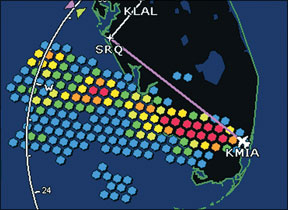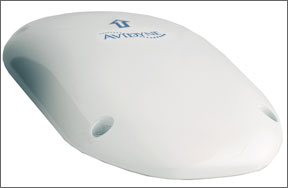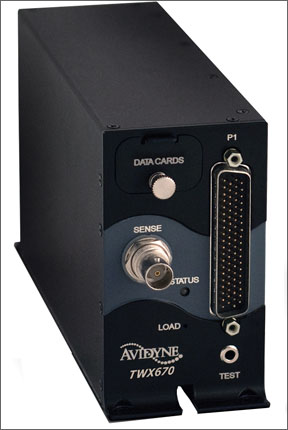Although satellite weatherlink seems to have permanently dented the Stormscope/Strike Finder market, Avidyne is forging boldly forward with a new sferics-based product called the TWX670 digital Tactical Weather Detection system. Its already being called a modern Stormscope. Are these guy nuts? Not necessarily. Dont forget, outside the U.S., weatherlink doesnt exist and some North American pilots still want sferics-based detection to go with their datalink. The TWX60 fills the need with real-time mapping of storms and aggressive filtering of noise responsible for bogus strikes. Although the price is high, this new device promises to simplify installation and it color codes the strike pattern, potentially taking the guesswork out of tactical storm avoidance.
Origins
Avidyne merged with Ohio-based Ryan International in 2005, forming the Avidyne Safety Systems Group. Ryan developed the original Stormscope technology back in the 1970s, eventually selling it to 3M who then passed it on to L-3. The Stormscope hasnt seen a major new product upgrade for years, so the TWX670 is a step-up product that owes its roots to Paul Ryans expertise. Its part of Avidynes MHAS (multi-hazard awareness system) which encompasses remote traffic and weather sensors, including the TAS600-series active traffic system and the MLB700 WSI-based and SIRIUS-delivered datalink product. The TWX670 is a three-piece system that will accommodate a choice of displays. A remotely mounted receiver/processor measuring 7.9 x 2.5 x 4.0 inches and weighing 1.4 pounds is connected to the ANT67 directional antenna, which weighs just shy of two pounds and can be mounted on top or bottom of the fuselage.
The antenna is a critical component of the system and like all sferics devices, its susceptible to stray electromagnetic noise. An antenna cable routed within close proximity to RF transmitters and servo actuators can cause false strikes and

degrade bearing accuracy, something that has dogged many a Stormscope installation and driven shops to distraction. While owners tolerate these imperfections, they do degrade performance. Avidyne has confronted this with an integrated spectrum analyzer-like tool that maps potential noise and displays it for the installers review. The noise analysis assesses the levels of ambient noise and can be accomplished while the system antenna is suction-cupped to various areas of the airframe. Finding a quiet spot is thus a trial and error process.
The processor can serve up to seven external displays and each display interfaces with its own bi-directional RS232 serial port. This allows control over the system through any of the displays. Contrast this with the L-3 WX500 Stormscope, which can drive four displays with only one controlling the system.
In the top-of-the-line configuration, the TWX670 would have an audio system input, magnetic heading and geo-referenced position inputs. Heading stabilization can originate from an HSI that has analog synchro or bootstrap output. GPS position places the storm data relative to aircraft movement. For example, if the storm is positioned off the left side of the aircraft, it will appear properly oriented as the aircraft flies away from the activity. Most GPS units can feed position to the system via RS232 or ARINC 429 and in our view, its worth the wiring effort to make it so..
The optional audio panel interface offers voice callouts of nearby lightning, while a remote audio mute switch provides a way to stifle the callouts when the passengers start to squirm. All of these options will drive the cost of installation skyward, so be sure to discuss the details with your installer.
Display Options
As we go to press, display options are still maturing, meaning that some integral features-namely the hexagonal-shaped color mapping of cells which Avidyne calls TwxCell, plus a combined cell and strike mode-wont be available yet unless you opt for the dedicated MHD300 display.
This is a 3-inch ATI color mapping display that can fit into an instrument cutout. Avidyne says that color functionality will be available for the popular EX500 MFD later this year. Garmin GNS400/500 series navigators as we’ll as the Garmin GMX200 MFD can play the TWX670, but with a presentation that mimics that of a WX500 Stormscope. Were also told that full support of the TWX670 on these products will require Garmin to write software for such inclusion.
The Avidyne MHD300 multi-hazard color display will play all of the data, including the TwxCell, color strike mode and cell and strike modes. The MHD300 also plays optional TAS traffic data and has a list price of $8995. The TWX670 and MHD300 combination carry a package price of $14,995-hardly what we would call inexpensive compared to legacy Stormscopes and Strike Finders.
Unique Features

So whats Avidyne selling for that price? The passive TWX670 detects and processes thunderstorm data by receiving electromagnetic energy from lightning through its directional antenna, which also determines the bearing of the strike. The processor determines range to the strike by measuring amplitude.
What makes the system different from other sferics devices is its ability to accurately detect and paint lightning at close range-from zero miles out to 200 miles from the aircraft. Clearly, its not in your interest to fly that close to a thunderstorm, but on approach, different rules apply. Thanks to digital signal processing and noise immunity, the receiver/processor is designed to filter the radial spread or splatter thats inherent in other systems, says Avidyne.
Further, the system uses color-coding to describe storm intensity-something no other sferics systems do. In our view, color coding is more useful for determining potential turbulence around build-ups or for route planning than for up close and personal penetration. As for the color coding interpretations, red is intense, orange is a transitional color between heavy thunderstorm activity and intense, yellow is heavy activity, green-yellow is another transitional color and green is moderate activity. Blue-green depicts building intensity soon to be green, while blue represents atmospheric instability. We suspect it will take some hours for pilots to learn the characteristics of this color mapping and, in our view, reading the colors wont be as simple as interpreting NEXRAD imagery.
Strikes, Cells
Up to 1024 strikes are shown as dots on the screen (color coded if the display supports color interface) at corresponding range and bearing relative to the nose of the aircraft. Whats interesting is that individual strikes will be present for a maximum of three minutes before refreshing, so pilot interaction to constantly clear the display is minimized.

Cell mode is essentially the grouping of individual strikes in a given area using hexagonal shapes which are color-coded based on intensity. Cell depiction is maintained onscreen for three minutes. Its simple to read: If the cell grows with the addition of more strikes, the area is intensifying. If the activity shrinks, strikes will drop out of view. Further, individual strikes might show as overlaid on the cells, which is useful for close-in tactical avoidance.
This is a combined strike and cell mode, which is intended as a way to define a storms characteristics. If you have a view out the window, this could be the most useful mode to operate in.
So-called region data displays the intensity of strikes shown on an active region of the screen. For example, the average strike rate per minute and trend (growing, unchanging or diminishing) within a defined region can indicate the storms intensity and whether its maturing. Avidyne defines a storm region as any area thats painted dark green up to red shading.
This data is only present when the display range allows viewing of a particular area of activity. Our sense is that this feature will be helpful for close analysis of a specific area of buildup. Other systems have a rate counter, but none are as interactive as the region option available on the TWX670.
Audio Callouts
A voice call-out option is an interactive feature that allows connection to an audio panel, much like the Avidyne traffic system. When lightning is detected within a five-mile area of the aircraft, the system chimes in with a lightning alert that includes the direction of the strike: “Lightning, two o clock,” for example.
If multiple strikes are detected in the same quadrant within a minute of the last callout, you’ll hear “frequent lightning ahead.” If you opt for this feature, connect it though a switched input, so you can turn it on or off, for obvious reasons. Discuss this detail with your installer before you pay for the option.
Were not sure we would go the extra distance for the audio reminder, frankly. After all, when was the last time you forgot that you were motoring through active thunderstorms? If you have, the audio option was made for you.
Conclusion
If youre looking for a modern sferics device, thats what the TWX670 is. For the time being, unless you buy the MHD300 dedicated display, however, you’ll miss some important features of the color-enhanced interface. We like the noise-filtering processor design and the considerations aimed toward the installation process. Given the number of systems out there compromised for lack of proper installation, shops should embrace this product.
But is the TWX670 the tactical weather system that pilots have been waiting for? At $7995 without a display, we doubt it. Its just too expensive against datalink systems. But for owners attuned to high-dollar upgrades and who want belt, suspenders and a backup pair of pants for tackling serious weather, the TWX670 will likely prove the ultimate sferics choice, once the display options have matured.
Larry Anglisano is
Aviation Consumers avionics editor. He works at Exxel Avionics in Hartford, Connecticut.

